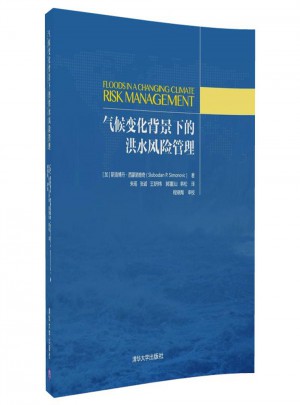

氣候變化及其日趨顯著的影響已成為全球共同關注與應對的重大問題。在氣候變化背景下,洪水與洪災表現出更大的不確定性,迫切需要將系統方法引入洪水風險管理,為解決防災、減災、應急響應與災后重建中跨學科的系列復雜難題,提供更為適合的分析工具。本書深入淺出講解了洪水風險管理的基本理念,論述了氣候變化對洪水風險特性的影響,探討了應對氣候變化的洪水風險管理決策過程與有效措施; 進而基于系統理論與案例分析詳細介紹了概率法與模糊集方法在洪水風險管理中的應用,展望了未來適應氣候變化的洪水風險管理前景。本譯著為相關領域科研、管理人員和大專院校師生提供了中英對照的讀本,具有良好的學習與借鑒價值。
本書向人們介紹如何針對未來氣候變化開展洪水風險評估,并據此及早制定更為有效的應對措施,尤其針對易于遭受洪水災害的地區和居民。
目錄|Contents
Foreword3
Preface5
Foreword7
Preface11
Acknowledgements13
Definitions15
Acronyms and abbreviations21
Chapter 1Flood risk management1
1.1The global flood problem4
1.2Problem context8
1.3Flood risk15
1.4How do we manage flood risk?17
1.5Systems view of flood risk
management19
1.6Conclusions23
1.7Exercises24
Chapter 2Climate change and risk of
flooding25
2.1Floods and their physical
characteristics27
2.2Climate change and variation
impacts35
2.3Approaches for dealing with
climate change49
2.4Conclusions55
2.5Exercises57
Chapter 3Risk management as adaptation to
climate change59
3.1Flood risk management decision
process63
3.2Approaches to flood risk management
as adaptation to climate change74
3.3An example: Climate changecaused flood
risk to municipal infrastructure,City
of London (Ontario,Canada)82
3.4Conclusions124
3.5Exercises125
Chapter 4Risk management: probabilistic
approach127
4.1Mathematical definition of risk129
4.2Classification of risk135
4.3Risk criteria138
4.4Probabilistic risk modeling141
4.5Probabilistic tools for flood risk
management147
4.6Conclusions213
4.7Exercises214
Chapter 5Risk management: fuzzy set
approach217
5.1Paradigm change219
5.2Introduction to fuzzy sets222
5.3Fuzzy risk definition241
5.4Fuzzy tools for flood risk management
under climate change249
5.5Conclusions307
5.6Exercises308
Chapter 6Future perspectives311
6.1Understanding climate change and
flood risk management313
6.2Adaptive flood risk management
under climate change316
6.3Risk communication319
6.4Conclusions323
References325
譯著序言3
譯者的話5
序言7
前言11
致謝13
術語15
縮略詞21
第1章洪水風險管理1
1.1全球洪水問題4
1.2洪水問題的內涵8
1.3洪水風險15
1.4如何管理洪水風險17
1.5洪水風險管理的系統觀點19
1.6結論23
1.7練習題24
第2章氣候變化與洪水風險25
2.1洪水及其物理特性27
2.2氣候變化和變異的影響35
2.3氣候變化的應對措施49
2.4結論55
2.5練習題57
第3章適應氣候變化的風險管理59
3.1洪水風險管理決策過程63
3.2適應氣候變化的洪水風險管理
措施74
3.3案例: 氣候變化導致加拿大安大略省
London市市政基礎設施
洪水風險82
3.4結論124
3.5練習題125
第4章風險管理: 概率法127
4.1風險的數學定義129
4.2風險類型135
4.3風險標準138
4.4概率風險模型的建立141
4.5洪水風險管理的概率工具147
4.6結論213
4.7練習題214
第5章風險管理: 模糊集方法217
5.1模式轉變219
5.2模糊集介紹222
5.3模糊風險的定義241
5.4氣候變化條件下洪水風險管理中的
模糊工具249
5.5結論307
5.6練習題308
第6章未來前景311
6.1了解氣候變化與洪水風險管理313
6.2氣候變化背景下適應性洪水風險
管理316
6.3風險溝通319
6.4結束語323
參考文獻325
第1章洪水風險管理|Flood risk management
Chapter 1Flood risk management
A flood is a very simple natural phenomenon that occurs when a body of water rises to overflow land that is not normally submerged (Ward,1978) At the same time,a flood is a very complex phenomenon that connects the natural environment,people,and the social systems of their organization Flooding causes loss of human life It damages infrastructure such as roads,bridges,and buildings,and hurts agricultural productivity because of lost crops and soil erosion Flood disaster relief often requires enormous funding Connectivity increases risksAs more links are present among the elements of natural,social,and technological systems,these systems develop unexpected patterns of connections that make breakdown more likelyWe are witnessing many catastrophic flood disasters European floods in 2002 caused more than 7 billion damage Hurricane Katrina caused flooding in 2005 that was the costliest natural disaster,as well as one of the five deadliest,in the history of the USA At least 1,836 people lost their lives in the actual hurricane and in the subsequent floods; total property damage was estimated at US$81 billion In June of 2006,northeastern Bangladesh disappeared under monsoon floods as rains drenched the region The floods stretched across hundreds of kilometers of what had been dry land a month earlier and inundated two thirds of the territory of the country Typhoon Morakot of 2009 was the deadliest typhoon to impact Taiwan in recorded history It created catastrophic damage in Taiwan,leaving 461 people dead and 192 others missing,and roughly US$33 billion in damage The storm produced huge amounts of rainfall,peaking at 2,777 mm (1093 in) The extreme amount of rain triggered enormous mudslides and severe flooding throughout southern Taiwan One mudslide buried the entire town of Xiaolin,killing an estimated 500 people In the wake of the flood,Taiwans President Ma Yingjeou faced extreme criticism for the slow response to the disaster,having initially deployed only roughly 2,100 soldiers to the affected regions Later additions of troops increased the number of soldiers to 46,000 The 2010 China floods began in early May The total death toll as of August 5 was 2,507 More than 305 million people in 28 provinces,municipalities,and regions were affected,while at least 12 million people had been evacuated because of the risk of flooding and landslides by early August As I am writing these words,Pakistans deadliest floods in decades have killed more than 1,500 people and overwhelmed government efforts to provide aid The floods death toll may rise to 3,000 Approximately 20 million people had been affected by floods by early August Regions downstream in the Indus River valley,where most of Pakistans 162 million people live,are bracing for floods that may damage crops
第1章洪水風險管理
洪水是一種非常簡單的自然現象。當洪水發生時,水體水位升高淹沒平常不受淹的陸地(Ward,1978)。同時,洪水也是一種非常復雜的現象,與自然環境、人類及其社會組織體系有密不可分的關系。洪水泛濫會導致人員傷亡,也會毀壞基礎設施,例如道路、橋梁和建筑物等,并因土壤侵蝕、農作物受損而破壞農業生產力。減輕洪災往往需要巨大的投入。現代社會多個系統之間的連通性使得洪水風險大大增加。隨著自然、社會和科技系統中各單元之間的聯系越來越多,這些系統間連接的故障就更可能呈現突發的模式。我們見證過很多大洪災: 2002年歐洲大洪水造成70億歐元的損失。2005年卡特里娜颶風引發的洪災造成了最為嚴重的經濟損失,這場災難也是美國歷史上傷亡最重的五大災難之一。在颶風災害和隨后的洪災中,至少有1836人死亡,總資產損失估計達到810億美元。2006年6月,因為持續的降雨,孟加拉國東北部變成了一片澤國。洪水淹沒的區域縱深達幾百公里,將一個月前還安然無恙的陸地全部淹沒。此次洪災使得孟加拉國2/3的領土被淹。2009年的莫拉克臺風是中國臺灣有記錄以來最致命的一場臺風,帶來了災難性的破壞,共有461人死亡,192人失蹤,經濟損失達33億美元。風暴使得降雨量激增,較大降雨量達2777 mm(1093 in)。極端降雨引發了臺灣南部嚴重的泥石流和洪水災害,其中,小林村整個村子都被泥石流掩埋,估計死亡500人。洪水暴發后,臺灣當局領導也因對災害救援反應遲緩而飽受批評。災害發生后,政府僅僅出動2100名士兵前往災區救援,難以滿足救災需求,所以又增援士兵46000人。2010年中國大陸的洪水始于5月,至8月5日死亡人數已達2507人,28個省、自治區和直轄市受災,受影響人口達305億人。截至8月初,中國至少有1200萬人因洪水和滑坡風險而被迫撤離。就在我寫這本書的時候(2010年,譯者注),巴基斯坦發生了近幾十年來最嚴重的洪災,死亡人口超過1500人,政府的救災努力收效甚微。洪災導致的死亡人口總數可能將達到3000人,截至2010年8月初,受洪災影響的人口約為2000萬人。Indus河下游地區有162億巴基斯坦人及大片的農田隨時可能被洪水淹沒。